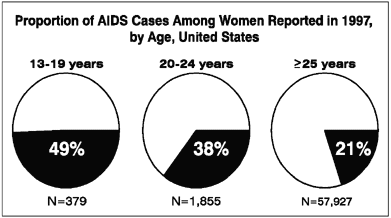
 |
Young People at Risk
Epidemic Shifts Further Toward
Young Women and Minorities June 1998
In the United States, HIV-related death has the greatest impact on young and middle-aged adults, particularly racial and ethnic minorities. HIV is the second leading cause
of death for Americans between the ages of 25 and 44. It is the leading cause of death
for African-American men and women in this age group. Many of these young adults
likely were infected as teenagers. It is estimated that half of all new HIV infections in
the United States are among people under 25, and the majority of young people are
infected sexually.
Because of the long and variable time between HIV infection and AIDS, surveillance of
HIV infection provides a much clearer picture of the impact of the epidemic in young
people than surveillance of AIDS cases. CDC recently announced results from a study
that analyzed data from 25 states(1) that had integrated HIV and AIDS reporting systems
for the period between January 1994 and June 1997. In these states, young people (aged
13 to 24) accounted for a much greater proportion of HIV than AIDS cases (14% versus
3%). Nearly half (44%) of the HIV infections in that age group were reported among
young females, and well over half (63%) were among African Americans. The study
also showed that even though AIDS incidence (the number of new cases diagnosed
during a given time period, usually a year) is declining, there has not been a comparable
decline in the number of newly diagnosed HIV cases among young people.
How Can We Improve Prevention Programs for Young People?
CDC's role is to provide communities with the best available science to guide
comprehensive HIV prevention programs. As part of this process, CDC conducts an
ongoing research synthesis process that seeks to identify the most recent and relevant
scientific findings from around the world, both published and unpublished, and make
them available to prevention program planners. CDC constantly combs the scientific
literature, reviews domestic and international scientific databases, and speaks with
colleagues around the world to identify effective interventions for all populations at
risk, including youth.
Young people's prevention needs are as diverse as young people themselves. To
reduce the toll AIDS takes on young Americans, a wide range of activities must be
implemented.
Comprehensive, ongoing prevention efforts are needed for each group entering
adolescence and young adulthood. All groups that exert influence over young people -
families, schools, peer groups and social systems, youth-serving agencies, religious
organizations - must be involved.
Eight-year trends from the Youth Risk Behavior Survey (YRBS) show both a leveling
of sexual risk behavior rates and increased condom use among sexually active
young people. Still, more than one-quarter of adolescents report initiating
intercourse by age 15. From 1990 through 1997 the percentages of high school
students who reported ever having had sex, having four or more partners, or having
intercourse in the 3 months prior to the survey all remained steady. In contrast,
overall condom use at last intercourse was up significantly, from 46% in 1990 to 57%
in 1997. Female and African-American students posted the largest increases in
condom use. While increased condom use is encouraging, YRBS findings indicate
that more must be done, and done earlier, to help young people delay initiation of
sexual activity and reduce risky sexual behaviors.
For young people, it is critical to prevent patterns of risky behaviors before they start.
HIV prevention efforts must be sustained and designed to reach each new generation of
Americans.
1. Alabama, Arizona, Arkansas, Colorado, Idaho, Indiana, Louisiana, Michigan, Minnesota, Mississippi, Missouri,
Nevada, New Jersey, North Carolina, North Dakota, Ohio, Oklahoma, South Carolina, South Dakota, Tennessee,
Utah, Virginia, West Virginia, Wisconsin, Wyoming Among 13- to 24-year-olds,
52% of all AIDS cases
reported among males in
1997 were among young men
who have sex with men
(MSM); 10% were among
injection drug users (IDUs);
and 7% were among young
men infected heterosexually.
In 1997, among young
women the same age, 49%
were infected heterosexually and 13% were IDUs.
Among 13- to 24-year-olds,
52% of all AIDS cases
reported among males in
1997 were among young men
who have sex with men
(MSM); 10% were among
injection drug users (IDUs);
and 7% were among young
men infected heterosexually.
In 1997, among young
women the same age, 49%
were infected heterosexually and 13% were IDUs.
Last Update: July 24, 1998
Centers for Disease Control & Prevention
National Center for HIV, STD and TB Prevention
Division of HIV/AIDS Prevention
email: hivmail@cdc.gov
Go to the CDC Updates Menu
Go to the Women & Children Menu
Go to the HIVpositive.us Main Menu